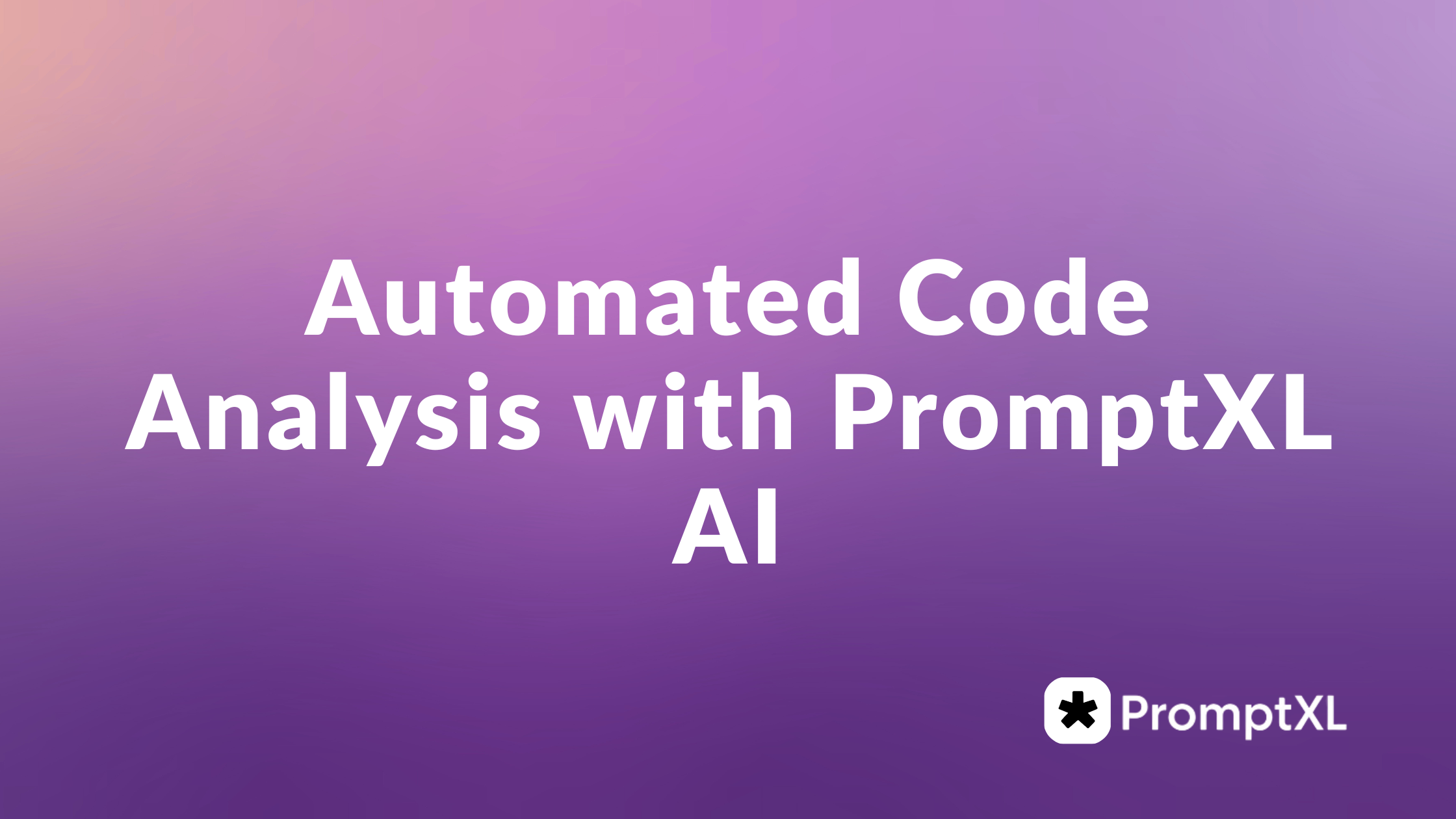
In today’s fast-paced digital world, building applications quickly is no longer a luxury — it’s a necessity. Tools like PromptXL leverage automated code analysis to turn raw ideas into production-ready applications in minutes. By analyzing project requirements, code structure, and dependencies, PromptXL allows entrepreneurs, product owners, and development teams to focus on ideas rather than complex infrastructure and manual coding tasks.
At its core, PromptXL leverages AI to interpret natural language descriptions of projects, automatically planning, documenting, and building applications without requiring users to write extensive code themselves. This is akin to having a virtual development team that understands your intent and translates it into a structured, production-ready solution. But how does such an AI system make sense of code at scale? And how does it achieve what we call automated code analysis? Let’s dive deep into the mechanics and strategy behind this innovation.

What is Automated Code Analysis and Why It Matters
Coding data is inherently complex. Unlike structured business data, code is highly unstructured, often spanning hundreds of files with dependencies, libraries, and evolving logic. Traditional methods for understanding this data involve manually reading, analyzing, or using basic static analysis tools, which are inefficient at large scale. Companies like Replit, which host millions of software repositories, face this challenge daily. They store petabytes of data across millions of repositories, tracking every code change, execution, and debugging event. Extracting meaningful insights from this data requires not only powerful computing infrastructure but also smart algorithms that respect user privacy while providing actionable information.
For PromptXL, the challenge is slightly different but equally complex. It needs to understand project requirements, anticipate dependencies, and generate code that aligns with user intent — all without human intervention. To do this, it employs automated code analysis, combining multiple techniques to efficiently interpret large volumes of code and convert it into structured, actionable outputs.
How PromptXL Uses Automated Code Analysis to Build Applications
Automated code analysis refers to the process of inspecting and interpreting code using algorithms and AI models rather than manual human review. This is critical for PromptXL, as it allows the system to:
- Identify project intent: Understand what the user wants to build from natural language descriptions.
- Analyze code structure: Examine the files, directories, dependencies, and functions to map the application’s architecture.
- Assess code quality: Measure complexity, detect errors, and optimize for performance.
- Generate actionable insights: Produce ready-to-deploy applications while maintaining scalability and efficiency.
Unlike traditional code parsers, which might only perform static analysis (examining the code without execution), PromptXL’s approach blends static analysis, dynamic behavior tracking, and AI-driven inference to deliver accurate, production-ready outputs.
Step 1: Translating Ideas into Structured Projects with Automated Code Analysis
The first step in PromptXL’s process is to interpret the user’s project description. Users describe their application in plain language — for example: “I want a task management app with user authentication and email notifications.” The AI then converts this description into a structured representation, outlining the modules, frameworks, and dependencies required for the application.
This structured representation forms the foundation for automated code analysis. By mapping natural language to a schema of project components, the system can reason about how different parts of the application should interact, anticipate potential pitfalls, and plan the architecture accordingly.
Step 2: Code Metadata Extraction
Once the project is conceptually mapped, PromptXL proceeds to analyze existing code or templates that it might leverage. The system collects metadata from code, including:
- File statistics: Number of lines, file types, directory structure.
- Code-specific metrics: Number of functions, classes, variables, cyclomatic complexity.
- Dependencies: External packages, libraries, and system requirements.
- Critical strings and keywords: Function names, variable identifiers, and file names that indicate intent.
By extracting these high-level features, PromptXL can summarize large codebases in a compact format without processing every single line of code in depth. This approach drastically reduces computational cost while retaining essential information needed for AI reasoning.
Step 3: Progressive Classification in Automated Code Analysis
PromptXL uses a progressive classification strategy, inspired by industry approaches like those at Replit. The system starts with coarse-grained analyses and incrementally applies more sophisticated filters as needed:
- Behavioral Data Analysis: Understand user patterns, such as frequently used frameworks or code templates.
- String Matching: Detect specific libraries or keywords relevant to project functionality.
- Abstract Syntax Tree (AST) Parsing: Examine the code’s structural elements, such as functions, loops, and conditionals. AST parsing allows AI to infer logic and detect code complexity.
- Dynamic Analysis & Linting: Execute or simulate code to detect errors, performance issues, or dependency conflicts.
- LLM Integration: Only after all prior steps, large language models (LLMs) may be used for nuanced understanding, such as predicting the user’s final application goals or the expected level of user expertise.
This layered approach ensures computational efficiency while maximizing insight quality. Only the most complex or ambiguous cases require the heaviest AI resources, keeping operations cost-effective.
Step 4: Compressing Code Representations
PromptXL creates compact representations of projects for further analysis. Instead of processing every file in its entirety, it captures critical elements — such as call graphs, key variable names, and dependency maps — that provide predictive power about project behavior and intent.
This compression enables the system to scale to thousands of projects simultaneously without incurring excessive computational or storage costs. It also maintains data privacy, as sensitive code segments can be abstracted while preserving analytical value.
Step 5: From Analysis to Deployment
After understanding project structure and logic, PromptXL can automatically generate code templates, modules, and full application scaffolding. It ensures:
- Consistency: All generated modules follow best practices and project conventions.
- Scalability: The application architecture can support future growth and integrations.
- Error Minimization: Code linting and AST-based validation reduce bugs before deployment.
- Optimized Workflows: The system intelligently organizes the project files, dependencies, and configurations to streamline the development process.
With these steps, users can move from idea to deployment in minutes, without worrying about infrastructure, code errors, or architecture challenges.
Benefits of PromptXL’s Automated Code Analysis
The AI-driven approach of PromptXL brings several advantages for developers and product teams:
- Speed: Rapid generation of production-ready code reduces project timelines dramatically.
- Accessibility: Non-technical users can build complex applications without writing code.
- Efficiency: Progressive classification and code compression minimize computational overhead.
- Insight-Driven: Metadata and AI analysis provide actionable insights for growth, optimization, and scaling.
- Privacy-Aware: Sensitive code and user data are abstracted, ensuring confidentiality and compliance.
These benefits make PromptXL an indispensable tool for startups, small teams, and enterprises that need to innovate fast while keeping resource costs under control.
Conclusion
PromptXL demonstrates how AI can transform software development by automating the traditionally complex tasks of planning, analyzing, and building applications. By leveraging automated code analysis, metadata extraction, AST parsing, and progressive classification, the system can interpret massive codebases efficiently while retaining accuracy, scalability, and privacy.
In essence, PromptXL lets entrepreneurs and developers focus on what truly matters: ideas and innovation. By removing the barriers of infrastructure, code complexity, and deployment challenges, it empowers teams to turn visions into reality at unprecedented speed.
Related Topic: AI Coding Platform: What is Vibe Coding With Promptxl

